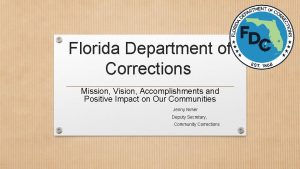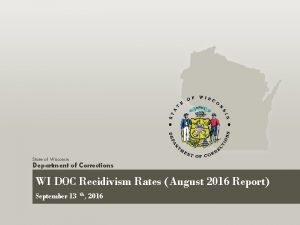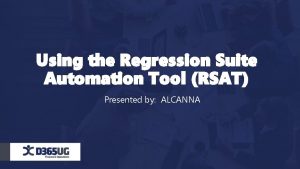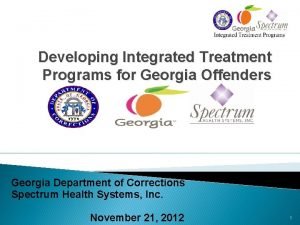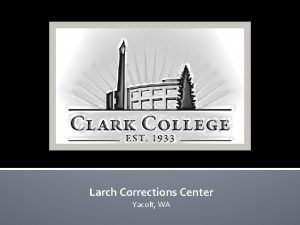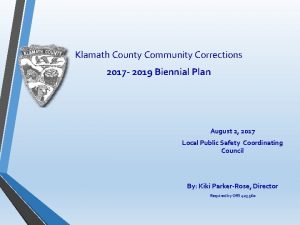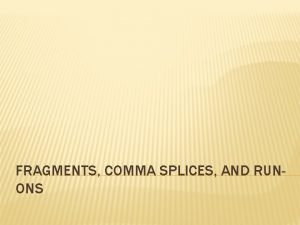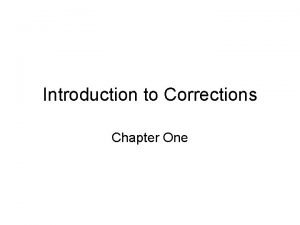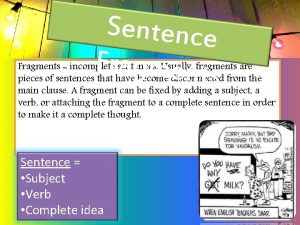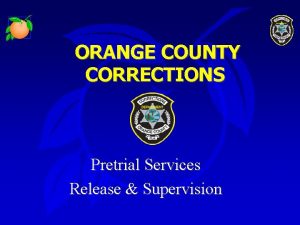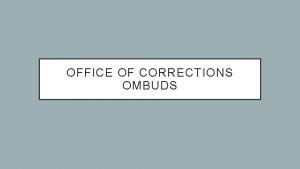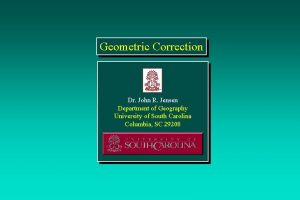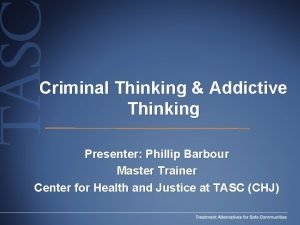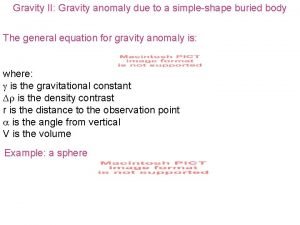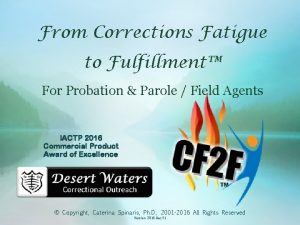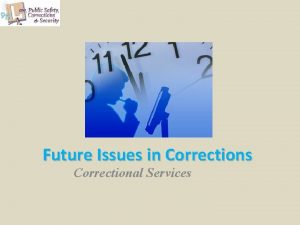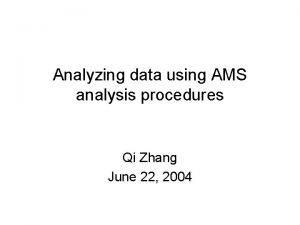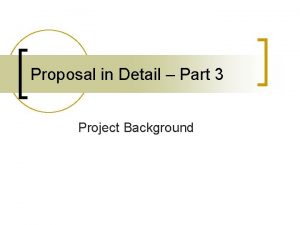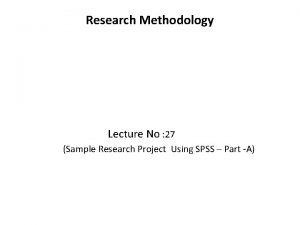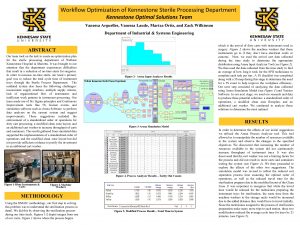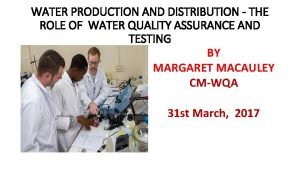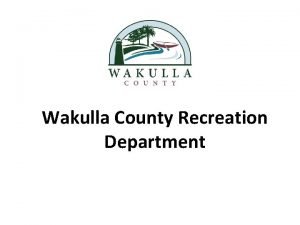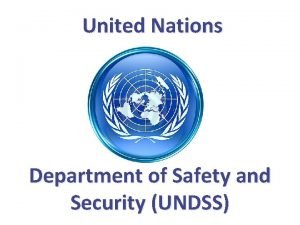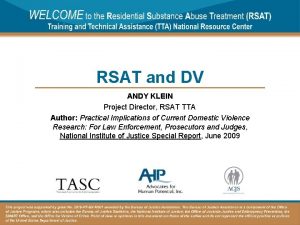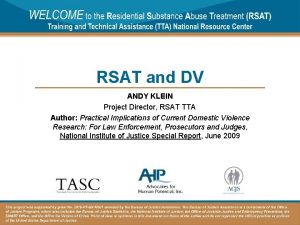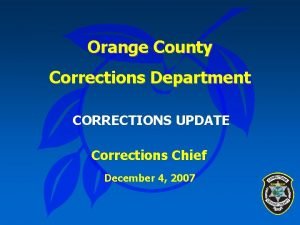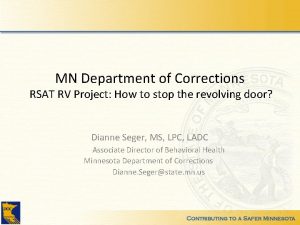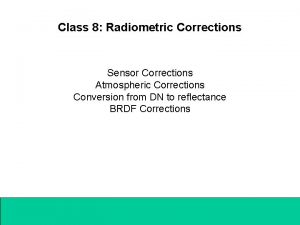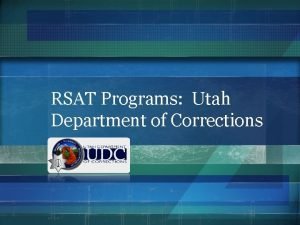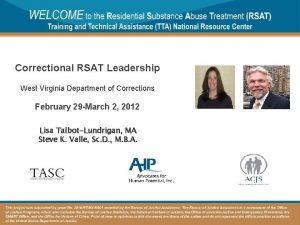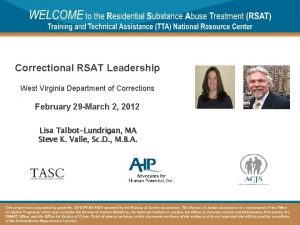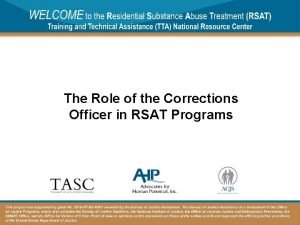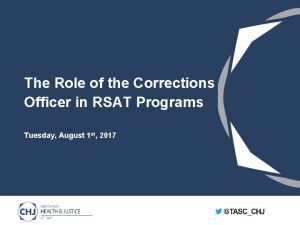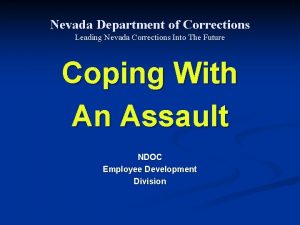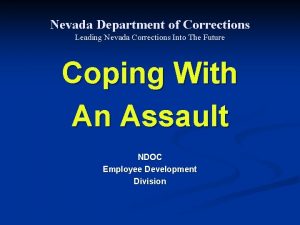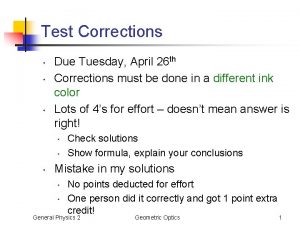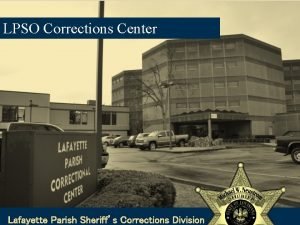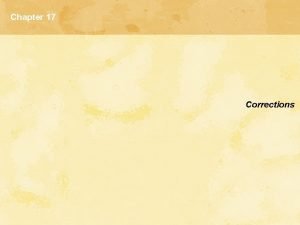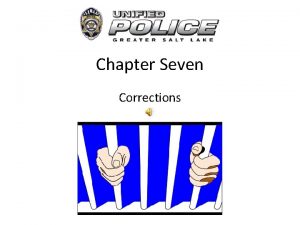MN Department of Corrections RSAT RV Project How












































- Slides: 44

MN Department of Corrections RSAT RV Project: How to stop the revolving door? Dianne Seger, MS, LPC, LADC Associate Director of Behavioral Health Minnesota Department of Corrections Dianne. Seger@state. mn. us

Minnesota Department of Corrections Prison Facilities

Classification Levels

Minnesota Prison Factors • Low rate of incarceration (49 th per capita) • Prison used for serious, high-risk offenders • Low rate of recidivism (three years after release): ü 36% new felony conviction ü 25% reincarcerated for a new felony

Community “Philosophy” Source: www. nicic. org/Features/State. Stats Wisconsin Minnesota State population 5. 6 M 5. 0 M Probation population 53 K 130 K 23 -24 K 9. 5 K 43% 7% Prison population % incarcerated

Offenses • • • Drugs Crim Sex Cond Homicide Assault Traffic/Accidents Burglary As of 1/1/10 1844 1623 1346 1122 796 624 19. 2% 16. 9% 14% 11. 7% 8. 3% 6. 5%

Type of Offenses (top six-7355) • • Person Drug Property DWI Other Weapons PSI Holds As of 1/1/10 4791 1844 1101 686 662 503 32 49. 8% 19. 2% 11. 5% 71% 6. 9% 5. 2%. 3%

CD Programs Mission Statement The mission of the MN DOC chemical dependency programs is to provide a therapeutic treatment environment that promotes abstinence from alcohol and other mood-altering chemicals and promotes personal responsibility for criminal conduct and thinking.

Did You Know? • Minnesota DOC is one of the state’s largest providers of CD treatment (over 800 treatment beds) • Available to adult and juvenile offenders at every state prison custody level except maximum (Oak Park Heights) • Continuum of CD services, including treatment readiness, primary long-term treatment, and aftercare/mentors, and release planning • Residential CD programs are specifically designed for offenders and address criminogenic and addiction issues

CD Treatment “Fast Facts” • 3, 800 newly-committed offenders and release violators assessed for CD abuse or dependency in FY 08 • 90% diagnosed as chemically abusive or dependent • 80% were directed to treatment • 34% of offenders directed to treatment enter a program prior to release: ü 1, 309 offenders entered treatment programs in FY 08 ü 89 treatment refusals • Those who do not complete treatment are referred to programs in the community

Correctional CD treatment • Long-term treatment is more effective, up to a year (mean LOS is 8 months in our primary treatment programs) • TC separated from general population • CBT approach with motivational enhancement strategies (Motivational interviewing) • Criminogenic Risk/Criminal thinking component • Recovery-oriented release/transitions planning • Hazelden/MN DOC Curriculum A New Direction • MN DOC RV’s are not generally given treatment opportunities—sentences are too short

Residential Treatment Parameters • 25 hours of programming per week: ü 12 hours “core” services (professional services, group + individual therapy, psycho-education, etc. ) ü 13 hours additional programming (education, support groups, homework, healthy physical activity, etc. ) • Staffing ratio of 12: 1 (females 8: 1) CIP 15: 1 and 10: 1 • Treatment addresses both addiction and criminogenic factors • Routinely audited against Certification Standards by Dept. of Human Services, Department of Public Safety, and DOC auditors

CD Program Outcome Evaluation 2, 260 offenders who were directed to treatment were released to the community in 2005: ü Approximately half participated in treatment o 72% treatment completion rate for all participants o 61% completion rate for DWI offenders ü Completion of treatment reduced risk of recidivism o 22% for rearrest o 20% for reconviction o 27% for reincarceration w/new offense ü Some program durational effects ü Greatest in primary programs of 180 days Source: DOC Chemical Dependency Program Evaluation, March 2008 www. doc. state. mn. us/publications/documents/03 -08 CDRecidivism. Evaluation. pdf

Challenge • Many/most RV’s come back to DOC directly or indirectly due to drug/alcohol abuse • 2011: 2200 release returns (without new sentence) • Efforts to identify the target population started in 2009 with reviewing 2008 data • Hypothesized that a short-term intervention may reduce recidivism with this subgroup with a much smaller expenditure of resources

An Examination of Chemical Dependency Treatment Needs of RV’s who Previously Completed Treatment • Research survey conducted in 2010: N= 50 RV’s • Survey was anonymous • Goal was to develop a treatment intervention targeted specifically for RV’s who had previously completed DOC treatment • Hypothesized that a short-term relapse prevention intervention may reduce recidivism with a subgroup of offenders, with a much smaller expenditure of resources

Survey Results • Well over half (61%) of respondents indicated their release revocation was related to the use of alcohol or other drugs • Twenty-six percent of respondents said they did not use after their release • Almost ¾ (73. 5%) rated their CD Treatment experience as “Positive” or “Very Positive. ” 14. 3% rated their Treatment experience as “Negative” or “Very Negative” • Nearly three-quarters (71%) acknowledged returning to criminal thinking patterns after release • 83. 7% felt they were prepared to maintain sobriety after their treatment and previous release.

Use of community resources • Seventy-five percent reported attending self-help meetings • About half (55%) said they obtained a sponsor • About one third (35%) reported participating in outpatient CD counseling or CD Halfway House • Eighty-eight percent said they felt there were people in the community who supported them

Relapse and Recidivism How long were you out? How long after release did you start using? • One or more years 38. 7% • 6 -12 months 24. 5% • Less than 6 months 35. 7% • Less than 30 days 8. 4% • 30 -90 days 16. 32% (first 90 days 24. 7%) • 3 -6 months 10. 2% • 6 -9 months 18. 4% • 9 -12 months 8. 2% • More than 2 years 2% Did not use 26. 5%

Offenders reported the following issues led to their use of alcohol or drugs after their release: • Stress • Relationship issues with family and/or significant others • Boredom • Depression • Difficulty finding housing • Difficulty finding employment • Challenges of supervision

Respondents reported the following components to be essential to a relapse prevention program • The opportunity to meet individually with a release planner prior to release • More thorough information on resources available to them upon release, such as housing lists, employment availability, support group connections, and access to health care • Instruction in how to manage personal finances • Stress management and coping skills • Motivation to maintain sustainability of recovery process

Program Participants RV @ MCF-LL Identified through HRU Must have completed DOC CD treatment Return to prison directly or indirectly related to substance abuse • Prefer to have at least some period of sobriety • Motivation for treatment (interview process) • •

Program Parameters • 90 -120 days • 2 therapists Caseload: 10 • Staff: – LADC’s (Licensed Alcohol and Drug Counselors) – Combination therapist/release planner

Program (cont) • Follows current certification standards – Hours of treatment (residential) – Staffing • Curriculum – Gorski’s RP with Chemically Dependent Criminal Offenders, and A New Direction – Emphasis on transitions – Restorative Justice elements – Individualized treatment

To date (12/12) • 84 served • 52 Graduated • 50 Released to Community • 12 Terminated by program • 8 Admin Term • 1 Quit Interviews with ex-offenders and supervising agents underway

Questions? Dianne Seger- Associate Director of Behavioral Health Minnesota Department of Corrections 1450 Energy Park Drive, St. Paul, MN 55108 Dianne. Seger@state. mn. us 651. 361. 7283

Addiction Management Systems Mark Day, Superintendent State Training School, Eldora, Iowa Bob Mc. Cartney, Executive Director, CEO Addiction Management Systems, Eldora, Iowa

State Training School (STS) STS Overview Male adjudicated delinquent population, ages 13 -18, youth offender waiver Accredited by the American Correctional Association Three years of downsizing, still provides relevant, cutting edge programs Basis for STS programs Motivational Interviewing Engages students, helps solve problems, annual staff training Cognitive Behavioral Techniques Assists students by helping them understand concerns and to develop a different set of motivators Addiction Management Systems (AMS) Three year license from the State of Iowa, Level I, extended outpatient Integrated contracted program for 21 years Same level of priority as education/clinical programs STS expectation – student applies himself

Public Order; 2; 1% Weapons; 4; 2% Sex Crimes; 21; 12% Crime Breakdown By Admission – 2011 Drugs; 11; 6% Property; 83; 47% Persons Drugs Weapons Persons; 54; 31% Sex Crimes Public Order

Admission Criteria The student must be at least 12 and must have committed a forcible felony (murder, sexual assault, first degree arson or burglary) OR Be at least 15 AND any of the following: • Aggravated misdemeanor/felony against a person (carrying a weapon) • A previous delinquent act • Prior out-of-home placement

STS Programming Clinical Character Counts Cognitive Life Skills Violence Intervention Program Suicide Prevention Program Honor Corps Health Curriculum Gang Resistance and Intervention Program Transitional Living Skills Residential Substance Abuse Treatment Challenge Course Sexual Abuse Program Suicide Prevention Group Educational 7 -12 Educational Program Vocational Programs Basic Auto Technology Basic Welding Technology Bakery Careers Computer Applications Air Cooled Engines Residential Construction Building Trades GED Prep and Testing Drama Art PE

AMS — A__ Making Suggestions Unmotivated population Identified through assessment, juvenile court, or parental concern Goals Help students explore how mood-altering chemicals have affected them Work to identify specific concerns about use Develop life alternatives Develop actions plans

Residential Substance Abuse Treatment (RSAT) Assessment

RSAT Assessment Program Qualifiers 17. 5 years or younger Between 6 months and 1 year stay Supervising county must be willing to provide aftercare support Prior history of treatment Manufacturing or distribution charges need documented history of problematic use If not appropriate for an ongoing group, reassessment will occur if openings are available

RSAT Assessment Testing/Information Standardized testing by Iowa Dept of Public Health AMS adds questions which are adolescent-specific CAST and SAIS evaluation Access to all social history via Qualified Service Organization Agreement

Residential Substance Abuse Treatment Planning

RSAT Planning Initial assessment within first 7 days at facility Initial Treatment Plan within 7 days in living unit Master Treatment Plan implemented within 30 days Interdisciplinary Care Plan (ICP) which includes consultation with Juvenile Court Officer Access to STS main file Student input on Initial Treatment Plan Master Treatment Plan

Residential Substance Abuse Treatment

RSAT Treatment Programs • Individual Counseling/Life Space Support • Bi-monthly • Monthly goals • Focus on Master Treatment Plan • Group Counseling • Phase 1 - “Bullets and Bomb Stage” • What has created difficulty? • Counselors help clarify • Phase 2 – “Passive Resistance Stage” • Change from working on surface issues to working on personal concerns • Willing to take personal issues to group therapy • Phase 3 – “Walk the Walk” • Quality of treatment work improves • Student develops “direction” for aftercare

RSAT Treatment Programs • AA/NA meetings • Sponsored by community at STS • Required attendance during stay • Required attendance on Trial Home Visits • STS clinical input • Ongoing Support • Personal monthly behavioral goal reviews • Focus on Master Treatment Plan • Discharge planning • Community based program reviews • E-Therapy • Perfect meeting/Skype • IM • Hard line phone conversations

RSAT Concerns 1. Students completing the RSAT program are near or at the end of their involvement in the Juvenile Justice System. There is little support/force to encourage their continued involvement in community based programs. 2. The State Training School provides services to students from the entire State of Iowa and it is difficult to have community based programs from the students’ home community take part in planning before the student returns to the community. 3. Many public community based programs are the same programs where the student failed prior to placement at STS. Students are reluctant to trust community based programs. Many of the programs are reluctant to accept appointments from these students in the referral process. Students don’t “play well with others. ”

RSAT Program Accomplishments 60 students successfully complete the program a year Students spend less time in the Special Treatment Unit for discipline Average length of stay 6. 5 months 95% referred 12 Step programming and community based counseling services Average student received 158 hours of counseling service FY 2011 cost: $3, 299. 45 or $20. 81 per hour

Contact Information Bob Mc. Cartney Addiction Management Systems State Training School 3211 Edgington Avenue Eldora, IA 50627 mailto: bmccart@dhs. state. ia. us 641 -858 -5402, Ext. 402

Q & A Period

Prevention and Treatment Needs of RSAT Clients at Risk for or Living with HIV/AIDS January 16, 2012 2: 00 – 3: 00 p. m. EST Each year, an estimated one in five individuals with HIV passes through a correctional facility. HIV prevention and screening of the offender population represents an opportunity to reduce the spread of HIV/AIDS, decrease related healthcare costs, and alleviate a great deal of human suffering. However, a lack of information and training, specifically within the correctional workforce, has been identified as a barrier to reducing the spread of HIV. This workshop is based on a new BJA- approved manual, vetted through the CDC, and available through the RSAT Training and Technical Assistance Center. Presenter: Niki Miller
 Florida department of corrections mission statement
Florida department of corrections mission statement Department of corrections wisconsin
Department of corrections wisconsin Rsat testing tool
Rsat testing tool Rsat program in georgia
Rsat program in georgia Rsat program
Rsat program Larch corrections center
Larch corrections center Klamath county community corrections
Klamath county community corrections Define corrections in criminal justice
Define corrections in criminal justice Comma splice examples and corrections
Comma splice examples and corrections Intro to corrections
Intro to corrections Which of the following is a sentence fragment marina
Which of the following is a sentence fragment marina Orange county community corrections
Orange county community corrections Joanna carns
Joanna carns Tangential scale distortion
Tangential scale distortion Criminal thinking patterns worksheets
Criminal thinking patterns worksheets Law public safety corrections and security answer key
Law public safety corrections and security answer key Accounting changes and error corrections
Accounting changes and error corrections Gravity corrections
Gravity corrections Gravity corrections
Gravity corrections Corrections fatigue
Corrections fatigue Debye huckel limiting law
Debye huckel limiting law Current and future issues in corrections
Current and future issues in corrections Essay corrections
Essay corrections Unraid write corrections to parity
Unraid write corrections to parity Fif airbeam
Fif airbeam The role of project management in achieving project success
The role of project management in achieving project success Background project proposal
Background project proposal Iteration workflows in software project management
Iteration workflows in software project management Cost duration graph
Cost duration graph Introduction to project management kathy schwalbe
Introduction to project management kathy schwalbe Software project evaluation
Software project evaluation Introduction to software project management
Introduction to software project management When conducting post project audits
When conducting post project audits Process indicators enable a software project manager to
Process indicators enable a software project manager to Ms project agile
Ms project agile Theoretical background example
Theoretical background example Project termination types
Project termination types Sterile processing department workflow
Sterile processing department workflow Strategic planning definition
Strategic planning definition Uta math
Uta math Swot analysis for procurement department
Swot analysis for procurement department Objective of warehouse
Objective of warehouse Wakulla community center
Wakulla community center Department st laghouat
Department st laghouat Undss logo
Undss logo
